

I am sensing a problem with flipped classrooms… I am writing my dissertation proposal, trying desperately to build a literature review about the uses of the internet in today’s classroom.
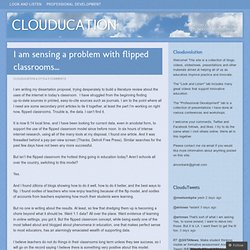
I have struggled from the beginning finding up-to-date sources in printed, easy-to-cite sources such as journals. I am to the point where all I need are some secondary print articles to tie it together, at least the part I’m working on right now, flipped classrooms. Trouble is, the data. I can’t find it. It is now 6:14 local time, and I have been looking for current data, even in ancdotal form, to support the use of the flipped classroom model since before noon. But isn’t the flipped classroom the hottest thing going in education today? Yes. And I found zillions of blogs showing how to do it well, how to do it better, and the best ways to flip. But no one is writing about the results. Flipped: Trends, Tips, Tools, and Myths. Based on colleague recommendation and personal interest, I checked out many great resources offered at ISTE that were related to the flipped classroom.

The concept of having students learn the material on their own in preparation for a class discussion is not new; I’m sure everyone can recall having to read chapters of text ahead of a college class. Flipping the Traditional Classroom » Higher Ed Online. One of the greatest benefits of technology is that it gives you options in the classroom.

What is a flipped classroom? Flipping the classroom is a recent method of instruction that has been brought about by the advances in the delivery and ubiquity of web video. It is an inversion of the traditional (class is for lecture and home is for homework). In the flipped and blended classroom, the students watch recorded lectures or absorb other material at home, and the class time is occupied by high levels of interaction and discussion intended to clarify and solidify the ideas and concepts of the material reviewed the night before.
Read The Flipped Class Manifest Why flip? Remember that in education, technology should be used to serve learning. Flipped Classroom: The Full Picture for Higher Education. The Flipped Classroom, as most know, has become quite the buzz in education.
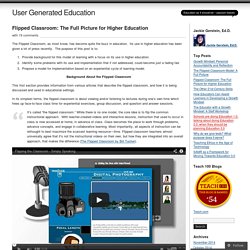
Its use in higher education has been given a lot of press recently. The purpose of this post is to: Provide background for this model of learning with a focus on its use in higher education.Identify some problems with its use and implementation that if not addressed, could become just a fading fad.Propose a model for implementation based on an experiential cycle of learning model. A College Teacher’s Reflection on Flipped Classrooms. “Trying anything new is risky.

Will this flipped classroom thing work? …. But I am anticipating the rewards will far outweigh the amount of work it’s taking. I am anticipating that the experience will be much, much richer for both my students and myself.” – from Suze Murphys, a college teacher on her flipped class. Www.edukates.com. Flipped Classroom- Give Your Students Time to Learn. Let's talk about flipped classrooms. The first time I heard about a flipped classroom, I decided to try it the very next day. I figured- "HEY! This can't be too difficult... I'll just set up a video camera and film the lecture I give in class". That was a mistake. After viewing the twenty-minute footage of myself trying to explain how to write an introduction paragraph, I realized three things: My voice is higher and more monotone than I thought it was.
It took me twenty minutes to explain something that should have taken five minutes. Only about half of the students listening to me probably actually understood how to write an introduction paragraph by the time I was done. Inadvertently, I proved exactly what flipped classrooms are trying to argue- that traditional teaching methods waste time. I was still slightly wary, however. Flipping the Classroom « Make EdTech Happen. In this series of posts I will focus on ways teachers can implement a blended learning model in their classroom.
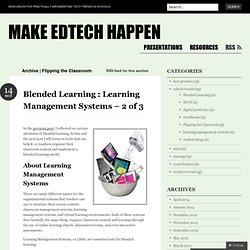
Each post will delve into related types of resources, with recommendations for implementation and samples of use. What is Blended Learning? Blended learning addresses the way most students learn now: through a combination of online tools and tried-and-tested in-class instruction. A blended educational model stands in contrast to models where learning is conducted solely online (through virtual schools and online courses), and models that introduces no online component (and they do exist).
According to Tina Barseghian, writing for KQED Mind/Shift, Simply stated, blended learning is combining computers with traditional teaching. Blended learning is a purposefully vague descriptor. Why Blend? Even though most teachers already incorporate a blended model into their instruction (whether they know it or not), it is important to analyze how online resources and web apps are being used.
The Rhetoric of MOOCs. The annual Computing Research Association conference is taking place this week at Snowbird in Utah, and one of today's plenaries is about online eduction and Massive Online Open Courses (MOOCs).
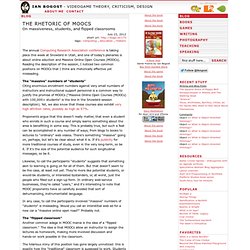
Reading the description of the session, I noticed two common positions on MOOCs that I think are rhetorically effective yet misleading. The "massive" numbers of "students" Citing enormous enrollment numbers against very small numbers of instructors and instructional support personnel is a common way to justify the promise of MOOCs ("Massive Online Open Courses (MOOCs) with 100,000+ students" is the line in the Snowbird session description). Yet, we also know that these courses also exhibit very high attrition rates, possibly as high as 97%. Proponents argue that this doesn't really matter, that even a student who enrolls in such a course and simply learns something about the area is benefitting in some way.
The answer might be as simple as novelty. The Flip: Why I Love It, How I Use It. Culture Teaching Strategies Flickr: Mike Baird By Shelley Wright.
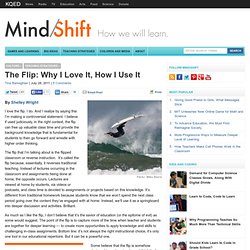
The Flipped Classroom Model: A Full Picture. Due to Khan Academy’s popularity, the idea of the flipped classroom has gained press and credibility within education circles.
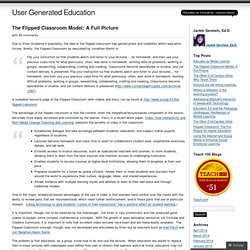
Briefly, the Flipped Classroom as described by Jonathan Martin is: Flip your instruction so that students watch and listen to your lectures… for homework, and then use your precious class-time for what previously, often, was done in homework: tackling difficult problems, working in groups, researching, collaborating, crafting and creating. Classrooms become laboratories or studios, and yet content delivery is preserved.
Flip your instruction so that students watch and listen to your lectures… for homework, and then use your precious class-time for what previously, often, was done in homework: tackling difficult problems, working in groups, researching, collaborating, crafting and creating.